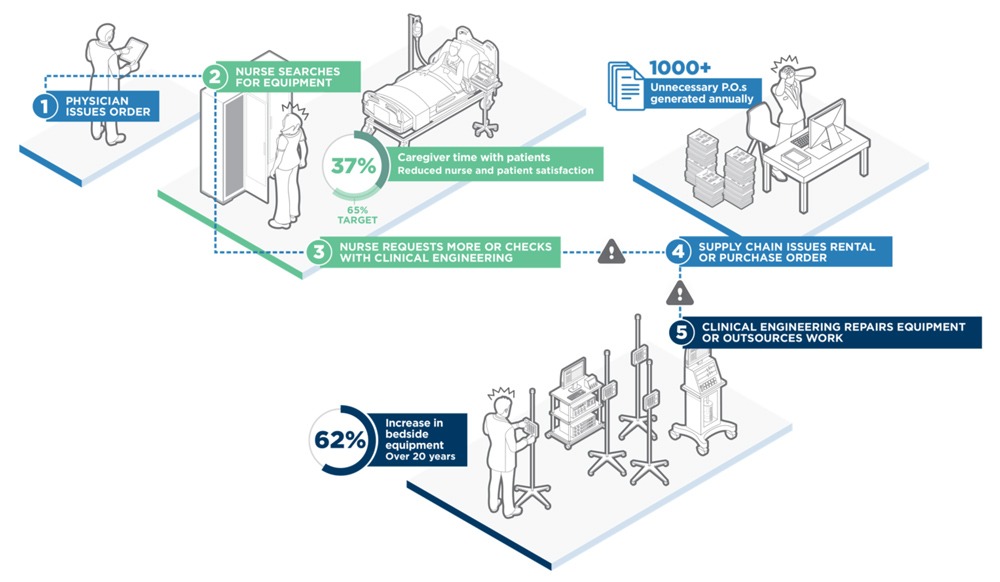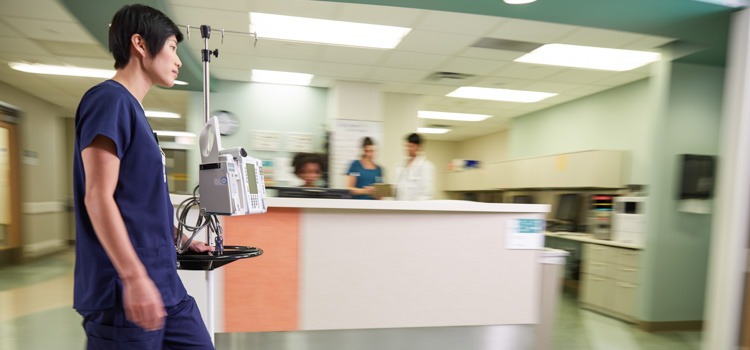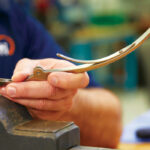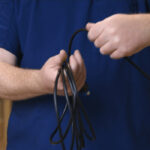The last two record-breaking flu seasons pushed the U.S. healthcare system to its limits — which was made even worse by nationwide shortages in common medical supplies like IV saline bags. Hospitals and health systems are gearing up for this flu season, building strategies for handling the census surges that await them in the coming months. Among these strategies, medical equipment rental remains a critical resource available for hospitals and health systems, providing immediate access to high-demand, essential medical devices and equipment such as infusion pumps, vents, beds and specialty surfaces.
To stay ahead of the rush, right now is the best time to take a close look at your equipment needs – that includes current inventory, potential capital expenses and your rental program. Looking at the broader picture will help make sure you’re not making common mistakes that lead to perceived equipment shortages, drive up rental costs and can even lead to dangerous patient care delays.
The Good: Rental Offers Cost-Effective Resources to Meet Peak Census Demand
Flu season invariably brings unpredictable census surges that strain medical equipment management programs. But the variable and unpredictable demand of flu season is representative of the larger trend of increased patient acuity and the rising standards hospitals and health systems face. Ensuring essential medical equipment is available and patient-ready — whether it’s an infusion pump or a specialty surface for an at-risk patient — it is more critical than ever to protecting patient safety, enhancing patient experiences and even securing optimal reimbursement rates.
In this landscape, renting equipment provides an efficient, cost-effective way for hospitals to rapidly obtain the essential equipment they need to deliver safe, seamless patient care. Moreover, renting equipment can help hospitals avoid the high upfront costs of purchasing additional equipment just to cover short-term peak census needs — as well as the ongoing management and maintenance costs of servicing and repairing that extra equipment.
Rental also offers an easy, agnostic path for clinicians to access a broader range of equipment. This is especially true and valuable when it comes to accessing the equipment needed for at-risk patient types (bariatric, fall risk, etc.). Predicting the demand for these patient types is incredibly difficult, which prompts most hospitals to avoid purchasing high volume of specialty equipment. But having the right therapy surfaces and beds to effectively treat these patient groups is critical to reducing length of stay and maximizing reimbursement.
The Bad: Process Breakdowns Can Lead to Perceived Equipment Shortages and Unnecessary Rentals
While flu season will certainly lead to medical equipment shortages in many hospitals, just as often, common process breakdowns lead to perceived shortages throughout the year. Here’s an example: A nurse cannot immediately access an infusion pump, which then requires her to spend time looking for and tracking down the equipment — searching other patient rooms, other nursing units or even “secret” hiding spots.
If still unsuccessful after checking these locations, the clinician will need to reach out to supply chain to request a medical device be brought up to their floor. If none are immediately available, or supply is low, supply chain will either need to contact a contracted vendor to request rental equipment, or the clinician or supply chain might reach out to clinical engineering. If the biomed department does not have a device ready for use, this will also initiate a rental request. Rinse, repeat, and suddenly rental spend has spiked (unnecessarily) and there are calls to purchase more equipment.
In reality, the hospital may have more than enough equipment to cover their needs — but that equipment is often underutilized due to one of the following issues:
- Equipment is lost within the facility: People put things in the wrong places. Several pieces of medical equipment are likely hiding in closets or corners where they were mistakenly left – or they walked right out the front door with a patient.
- There’s a backlog in Clinical Engineering: CE teams are managing more medical equipment than ever — and the amount continues growing. Service backlogs often mean owned equipment sits idle, awaiting repair, even as demand surges.
- The equipment is there — but it’s not patient-ready: Process breakdowns also commonly lead to equipment not being properly cleaned or serviced in between patients. At best, this leads to care delays as a nurse cleans a device. Often, it results in an additional rental or purchase order.
- There is no dedicated process: Equipment management spans multiple departments. Without a centralized process ensuring clean equipment is accessible, there exists a cycle of waste that leads to unnecessary request for more rental equipment.
Each of these all-too-common issues are immediately recognizable to any nurse. All three result in a perceived equipment shortage that can lead to unnecessary rental — and delay patient care. Perceived equipment shortages are often pretty easy to spot: Look for peaks in rental costs that do not reflect or align with your census demand.

While renting more than needed is one issue, not renting enough is another. In the quest to reduce overspending on unnecessary rentals, some hospitals decide to increase capital purchases instead. Even though this could relieve immediate demand, it’s not always the best long-term solution. This is because the costs of the initial purchase, combined with the ongoing costs associated with biomedical maintenance and service, put an added burden on supply chain and the clinical engineering department. Plus, in the end, purchasing more equipment may simply mask the underlying issue of low utilization.
In fact, over a 15-year period, service and maintenance costs associated with mobile medical equipment (MME) nearly doubled. That means for a 400-bed hospital that used to spend $662,400, the cost to service and maintain MME has swelled to more than $1,257,000 each year. And that doesn’t even include the price to purchase the equipment in the first place. For every piece of additional equipment purchased, those costs continue to increase – not to mention the burden on the clinical engineering department to manage the growing service requirements for a larger inventory.
In the end, purchasing more equipment may simply mask the underlying issue of low utilization and eventually lead to more purchase or rental requests when process breakdowns occur.
The Ugly: A Hidden Risk Most Providers Miss
While perceived shortages and resulting unnecessary rentals drive up costs, there’s another risk that more directly impacts patient care: third-party rental providers are not required to adhere to the same high-level, nationally recognized quality and patient safety standards as manufacturers — a gap that is shockingly unknown.
In today’s healthcare environment — where small factors play a big role in clinical quality, patient safety and even reimbursement rates — there’s simply no room for risk. And there’s no such thing as a harmless shortcut. Yet the troubling reality is that while a select few rental vendors now self-adhere to critical, risk-reducing ISO 13485:2016 standards for their medical equipment management, most are either not certified or are certified to a less stringent ISO 9001:2015. In practice, this means critical life-saving medical devices may not be maintained to the standards that you expect — which could lead to poor performance or even equipment failures that threaten patient safety.
The Goal: Rent Medical Equipment Based on What You Truly Need
The ideal approach to equipment rental is to make capital purchases to cover equipment needs for average daily census, while renting during times of peak census. Establishing a peak-need rental strategy reduces capital acquisition costs — as well as the associated maintenance costs — while enabling you to ensure seamless patient care during high-demand periods. And if done correctly, employing a smarter rental strategy could have a substantial positive financial impact on your facility — eliminating thousands in wasted spending on unnecessary rental or capital acquisition.
Tips for Implementing an Efficient Rental Strategy
- Review your census and rental trends. Too little rental and you can end up with more equipment than you need, driving up maintenance spend and still end up with equipment shortages that frustrate clinicians and cause care delays. Too much rental and you’re overspending on equipment you don’t need. Achieving the right balance requires understanding your rental history, your current inventory utilization and census trends (annual vs. average daily census). Moreover, if your rental spending does not align with fluctuations in census, there’s likely a broader issue.
- Evaluate your capital purchases. Start by considering what is driving your capital purchases. Are you buying based on average patient census — or purchasing to meet a perceived need? Do you have equipment sitting idle for most of the year? Do you know what your current equipment utilization rate is? Many facilities linger around 40%, while peer facilities with effective equipment management strategies are lifting utilization rates above 75%.
- Discuss your rental needs with your third-party provider. Your rental partner should be able to help your facility understand the good and bad of your rental practices. Your provider should be able to give you full visibility into your rental costs — and how they align (or don’t align) with census fluctuations. Finally, your rental provider should be able to offer proactive insights that help you identify issues that drive unnecessary rental — such as those that cause perceived shortages — and work with you to create a peak-need rental strategy that reduces capital acquisition costs and optimizes operational spending, while ensuring appropriate coverage to drive seamless patient care.
Let Agiliti Help You Get Smart About Rental
Talk to an Agiliti representative to learn how we can help you build a smart rental strategy that meets dynamic demands and keeps costs in check. Click the link below to get a free Rental Usage Assessment from Agiliti. We’ll walk through your rental usage and costs, compare against average daily census, and show you how you can rent smarter.













